forms of honey
3 Delicious Forms of Honey (#1 is Rare!)
There are many forms of honey and understanding the variety will certainly help you pick a more appropriate form from the supermarket when you wish to combine honey with other ingredients used in the preparation of foods. Try out the various tastes and forms of honey when you have the chance!
1. Comb Honey
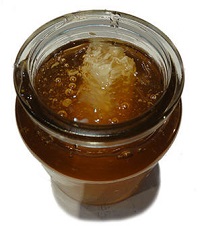
Amongst the forms of honey, this is probably the most difficult to find – comb honey, but sometimes you can find a jar of liquid honey to which a piece of cut comb has been added. Before the invention of honey extracting device, honey is mostly produced in the form of honeycombs. Unless you get directly from the honeybee farms, today, very little honey is offered in this form.
Comb honey is raw pure honey sections taken straight from the hive – honey bees’ wax comb with no further handling at all. It is the most unprocessed form in which honey comes — the bees fill the hexagon shaped wax cells of the comb with honey and cap it with beeswax. You can eat comb honey just like a chewy candy. Because the honey in the comb is untouched and is deemed to be pure, honey presented in this form comes with a a relatively higher price tag.
Read about my very first encounter, first bite of honeycomb.
2. Liquid honey
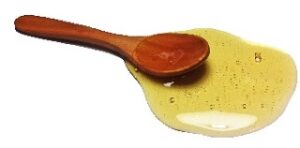
You can easily find this honey everywhere. As it seems, this is the most common form of honey in most places, and thus most familiar to consumers.
Clear, liquid honey can be raw or pasteurized. It has been filtered (in varying extents depending on the honey supplier/packer) to remove fine particles, pollen grains, and air bubbles after being extracted from the honey comb by centrifugal force or gravity. Because liquid honey mixes easily into a variety of foods, its uses are diverse. It is used as a syrup for pancakes and waffles and in a wide variety of recipes (Honey National Board), and it’s especially convenient for cooking and baking.
3. Cream honey
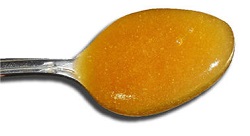
If you are one of those who complain that honey is messy to use, cream honey, which is also known as whipped honey, spun honey, granulated honey, or honey fondant, would be an excellent alternative to liquid honey. Cream honey does not drip like liquid honey, has a smooth consistency and can be spread like butter.
Honey is creamed by having one part finely granulated honey blended with nine parts liquid honey. The mixture is then placed in cool storage to promote rapid granulation and produce a small crystal structure that results in a smooth creamy texture. – hence creamed honey.
Because many floral varietals of raw honey crystallize quickly and appear as coarse sugary crystals, many suppliers overcome this issue by creaming their honey. During creaming, the precisely controlled crystallization process also lightens the color of honey, but does not affect the taste and nutritional goodness at all.
For instance, creamed premium lavender honey from the south of France is white in the jar, however for those who live in warmer climate countries, you probably might have noticed that the same cream honey purchased from the supermarket appears to turn darker in color and becomes runnier when placed in room temperature over time. This phenomenon shows that the warm temperature has returned the honey its original liquid state.
PS: Honey does not remain stable if the moisture content is too high. No reputable honey supplier would add water to honey, as this would cause the honey to ferment and emit an alcoholic smell. But pure honey harvested in warm humid countries such as Malaysia, Indonesia has a higher tendency to ferment over time, especially when not stored air-tight. Also, you may notice that honeys in these countries are usually not found in the creamed form because they are relatively less viscous and do not crystallize as quickly.
Color and Flavor of Honey
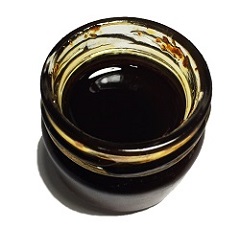
Color is used in the honey industry as a convenient measure of honey flavor and aroma. Generally, lighter honeys have a milder flavor and darker honeys have a more robust flavor. The color and flavor of honey is largely determined by the floral source of the nectar.
However, exposure to heat and storage time may affect honey’s quality and color. Normally, the darkening of honey occurs more rapidly when honey is stored at high temperatures. Also, honey appears lighter in color after it has granulated, which is why most creamed honeys are opaque and light in color.
Related Articles on Forms of Honey
1) Debunking myths of honey that has turned into coarse sugary granules over time: Crystallization of Honey.
2) Most frequently asked questiosn about pure honey, creamed honey versus clear liquid honey, crystallisation of honey, honeycomb, monofloral varietals, darkening of honey, viscous versus runny honey, honey storage in: Frequently Asked Information About Honey.
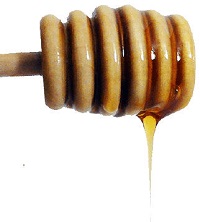
3) Raw, pure, organic, which honey do you choose? Read Which Honey to Buy?
4) Why raw honey is best. More in: What is Raw Honey
5) How much do honey labels mean to you? More in: Eating Real Honey?
6) Find out what is honey crystallization, pasteurization, and know how to best store honey: Honey Storage Tips.
7) Is honey powder made of 100% honey?: What in the World is Honey Powder?.
8) Some consumers assume cream or whipped honey is the most superior form of honey. Is it true? Find out in: Sticky Facts about Cream Honey.
End of “3 Delicious Forms of Honey (#1 is Rare!)” Back to “Frequently Asked Information About Honey”